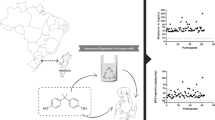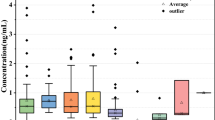Abstract
The aims of this study were to determine bisphenol A (BPA) levels in breast milk and urine specimens of healthy mother and exclusively breastfed infant pairs having no known BPA exposure, and also to examine the relationship between BPA levels and possible BPA exposure history. Forty mothers and their 1–2-month-old exclusively breastfeed infant were included in the study. The questionnaires about sociodemographic characteristics and possible BPA exposure history were filled out. Breast milk and urine samples were taken. BPA analyses of these samples were conducted using high-performance liquid chromatography coupled with mass spectrometry. All mother-infant pairs showed detectable BPA concentrations. The geometric means of BPA levels in breast milk, maternal urine, and infant urine were determined as 0.12 μg/L (0.03–0.59), 0.12 μg/L (0.03–0.73), and 0.13 μg/L (0.02–0.44), respectively. Infants whose mothers were consuming yoghurt in plastic containers had relatively higher urinary BPA levels (p = 0.00). Mothers consuming hot beverages in plastic glass showed higher breast milk BPA levels (p = 0.033). There were no statistical associations between BPA levels and the use of plastic materials and tools (p > 0.05).
Conclusion: The measurable BPA concentrations in all breast milk specimens of healthy mothers may reflect possible exposure from dietary or non-dietary sources. Exclusively, breastfed healthy infants without any known BPA exposure may be exposed to BPA from their mothers through breastfeeding.
What is Known: | |
• Fetuses, neonates and infants are exposed to BPA from their mothers through placental transfer and breastfeeding. • Breast milk is considered a continuous low-level exposure to BPA. | |
What is New: | |
• BPA was detected in 100% of maternal urine, infant urine, and breast milk in healthy mother-infant pairs having no known BPA exposure. • The measurable amount of BPA in breast milk and infant urine may reflect possible BPA exposure of mother-infant pairs. |



Similar content being viewed by others
Abbreviations
- BMI:
-
Body mass index
- BPA:
-
Bisphenol A
- HPLC:
-
High-performance liquid chromatography
- LC-MS/MS:
-
High-performance liquid chromatography coupled with mass spectrometry
- PVC:
-
Polyvinylchloride
- UHT:
-
Ultra high temperature
References
Andaluri G, Manickavachagam M, Suri R (2018) Plastic toys as a source of exposure to bisphenol-A and phthalates at child care facilities. Environ Monit Assess 190:65
Arbuckle TE, Davis K, Marro L, Fisher M, Legrand M, LeBlanc A, Gaudreau E, Foster WG, Choeurng V, Fraser WD, the MIREC Study Group (2014) Phthalate and bisphenol A exposure among pregnant women in Canada — results from the MIREC study. Environ Int 68:55–65
Arbuckle TE, Weiss L, Fisher M, Hauser R, Dumas P, Bérubé R, Neisa A, LeBlanc A, Lang C, Ayotte P, Walker M, Feeley M, Koniecki D, Tawagi G (2015) Maternal and infant exposure to environmental phenols as measured in multiple biological matrices. Sci Total Environ 508:575–584
Balakrishnan B, Henare K, Thorstensen EB, Ponnampalam AP, Mitchell MD (2010) Transfer of bisphenol A across the human placenta. Am J Obstet Gynecol 202(4):393.e1–393.e7
Braun J, Kalkbrenner AE, Calafat AM, Bernert JT, Ye X, Silva MJ, Barr DB, Sathyanarayana S, Lanphear B (2011) Variability and predictors of urinary bisphenol A concentrations during pregnancy. Environ Health Perspect 119(1):131–137
Calafat AM, Slakman AR, Silva MJ, Herbert AR, Needham LL (2004) Automated solid phase extraction and quantitative analysis of human milk for 13 phthalate metabolites. J Chromatogr B Anal Technol Biomed Life Sci 805:49–56
Calafat AM, Weuve J, Ye X, Jia LT, Hu H, Ringer S, Huttner K, Hauser R (2009) Exposure to bisphenol A and other phenols in neonatal intensive care unit premature infants. Environ Health Perspect 117(4):639–644
Cao XL, Popovic S, Arbuckle TE, Fraser WD (2015) Determination of free and total bisphenol A in human milk samples from Canadian women using a sensitive and selective GC-MS method. Food Addit Contam Part A 32(1):120–125
Chevalier N, Fénichel P (2015) Bisphenol A: targeting metabolic tissues. Rev Endocr Metab Disord 16:299–309
Duty SM, Mendonca K, Hauser R, Calafat AM, Ye X, Meeker JD, Ackerman R, Cullinane J, Faller J, Ringer S (2013) Potential sources of bisphenol A in the neonatal intensive care unit. Pediatrics 131(3):483–489
EFSA (2015) Scientific opinion on the risks to public health related to the presence of bisphenol A (BPA) in foodstuffs: executive summary. EFSA J 13:3978
Geens T, Aerts D, Berthot C, Bourguignon JP, Goeyens L, Lecomte P, Maghuin-Rogister G, Pironnet AM, Pussemier L, Scippo LM et al (2012) A review of dietary and non-dietary exposure to bisphenol-A. Food Chem Toxicol 50:3725–3740
Georgescu B, Georgescu CE (2013) Bisphenol A levels in commercial milk, infant formula and dairy products. Anim Biol Anim Husb 5:171–174
Hines EP, Mendola P, von Ehrenstein OS, Ye X, Calafat AM, Fenton SE (2015) Concentrations of environmental phenols and parabens in milk, urine and serum of lactating North Carolina women. Reprod Toxicol 54:120–128
Koch HM, Gonzalez-Reche LM, Angerer J (2003) On-line clean-up by multidimensional liquid chromatography-electrospray ionization tandem mass spectrometry for high throughput quantification of primary and secondary phthalate metabolites in human urine. J Chromatogr B Anal Technol Biomed Life Sci 784:169–182
Lee BE, Park H, Hong YC, Ha M, Kim Y, Chang N, Kim BN, Kim YJ, Yu SD, Ha EH (2014) Prenatal bisphenol A and birth outcomes: MOCEH (mothers and children’s environmental health) study. Int J Hyg Environ Health 217:328–334
Lee J, Choi K, Park J, Moon HB, Choi G, Lee JJ, Suh E, Kim HJ, Eune SE, Kim GH et al (2018) Bisphenol A distribution in serum, urine, placenta, breast milk, and umbilical cord serum in a birth panel of mother–neonate pairs. Sci Total Environ 626:1494–1501
Mendonca K, Hauser R, Calafat AM, Arbuckle TE, Duty SM (2014) Bisphenol A concentrations in maternal breast milk and infant urine. Int Arch Occup Environ Health 87(1):13–20
Mercogliano R, Santonicola S (2018) Investigation on bisphenol A levels in human milk and dairy supply chain: a review. Food Chem Toxicol 114:98–107
Migeot V, Dupuis A, Cariot A, Albouy-Llaty M, Pierre F, Rabouan S (2013) Bisphenol A and its chlorinated derivatives in human colostrum. Environ Sci Technol 47(23):13791–13797
Mikołajewska K, Stragierowicz J, Gromadzińska J (2015) Bisphenol A – application, sources of exposure and potential risks in infants, children and pregnant women. Int J Occup Med Environ Health 28(2):209–241
Nachman RM, Hartle JC, Lees PSJ, Groopman JD (2014) Early life metabolism of bisphenol A: a systematic review of the literature. Curr Environ Health Rep 1(1):90–100
Nakao T, Akiyama E, Kakutani H, Mizuno A, Aozasa O, Akai Y, Ohta S (2015) Levels of tetrabromobisphenol A, tribromobisphenol A, dibromobisphenol A, monobromobisphenol A, and bisphenol A in Japanese breast milk. Chem Res Toxicol 28(4):722–728
Rubin BS (2011) Bisphenol A: an endocrine disruptor with widespread exposure and multiple effects. J Steroid Biochem 127:27–34
Stefanidou M, Maravelias C, Spiliopoulou C (2009) Human exposure to endocrine disruptors and breast milk. Endocr Metab Immune Disord Drug Targets 9(3):269–276
Vandenberg LN, Maffini MV, Sonnenschein C, Rubin BS, Soto AM (2009) Bisphenol-A and the great divide: a review of controversies in the field of endocrine disruption. Endocr Rev 30(1):75–95
Vandenberg LN, Chahoud I, Heindel JJ, Padmanabhan V, Paumgartten FJR, Schoenfelder G (2010) Urinary, circulating, and tissue biomonitoring studies indicate widespread exposure to bisphenol A. Environ Health Perspect 118:1055–1070
Völkel W, Kiranoglu M, Fromme H (2011) Determination of free and total bisphenol A in urine of infants. Environ Res 111:143–148
WHO (World Health Organization). Joint FAO/WHO expert meeting to review toxicological and health aspects of bisphenol A: summary report including report of stakeholders meeting on bisphenol A1–5 November 2010, Ottawa, Canada
Ye X, Kuklenyik Z, Needham LL, Calafat AM (2005) Automated on-line column switching HPLC–MS/MS method with peak focusing for the determination of nine environmental phenols in urine. Anal Chem 77:5407–5413
Ye X, Bishop AM, Needham LL, Calafat AM (2008) Automated on-line column-switching HPLCMS/MS method with peak focusing for measuring parabens, triclosan, and other environmental phenols in human milk. Anal Chim Acta 622(1–2):150–156
Yi B, Kim C, Park M, Han Y, Park JY, Yang M (2013) Association between endocrine disrupting phenols in colostrums and maternal and infant health. Int J Endocrinol Article ID 282381
Zimmers SM, Browne EP, O’Keefe PW, Anderton DL, Kramer L, Reckhow DA, Arcaro KF (2014) Determination of free bisphenol A (BPA) concentrations in breast milk of U.S. women using a sensitive LC/MS/MS method. Chemosphere 104(Supplement C):237–243
Funding
The study is supported by Ankara University Research Fund (Project code 16 L0230005).
Author information
Authors and Affiliations
Contributions
Dr. Sayıcı prepared the application report for funding source, designed the data collection instruments, collected data, and performed the statistical analysis.
Prof. Orhon conceptualized and designed the study, designed the data collection instruments, revised the application report for funding source, performed the statistical analysis, interpreted the data, and prepared and edited the manuscript.
Assoc. Prof. Topcu collected data, and interpreted the statistical data.
Prof. Ulukol supervised the data collection process.
Prof. Baskan supervised the data collection process.
All authors approved the final manuscript as submitted and agree to be accountable for all aspects of the work.
Corresponding author
Ethics declarations
Conflict of interest
The authors declare that they have no conflict of interest.
Ethical approval
All procedures performed in studies involving human participants were in accordance with the ethical standards of the institutional research ethics committee and with the 1964 Helsinki declaration and its later amendments or comparable ethical standards.
Informed consent
Informed consent was obtained from all individual participants included in the study.
Additional information
Communicated by Mario Bianchetti
Publisher’s note
Springer Nature remains neutral with regard to jurisdictional claims in published maps and institutional affiliations.
Rights and permissions
About this article
Cite this article
Sayıcı, I.U., Simsek Orhon, F., Topçu, S. et al. Preliminary study on bisphenol A levels and possible exposure history of mother and exclusively breastfed infant pairs. Eur J Pediatr 178, 541–550 (2019). https://doi.org/10.1007/s00431-019-03329-4
Received:
Revised:
Accepted:
Published:
Issue Date:
DOI: https://doi.org/10.1007/s00431-019-03329-4




